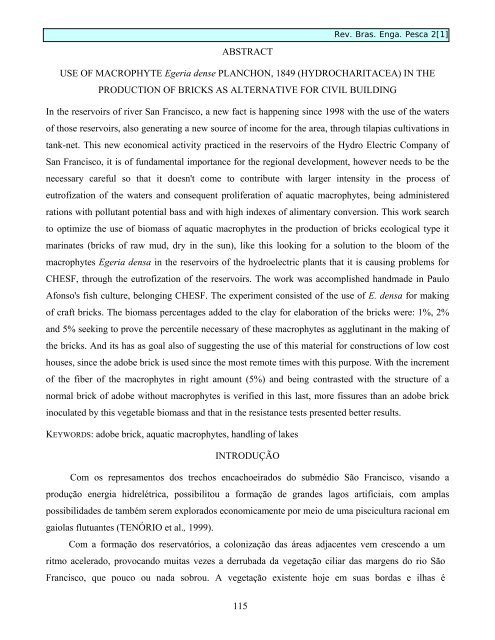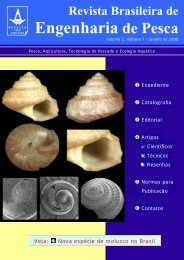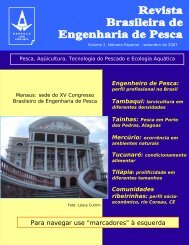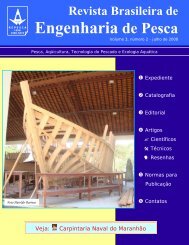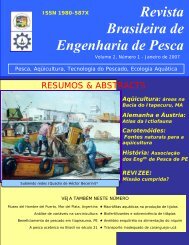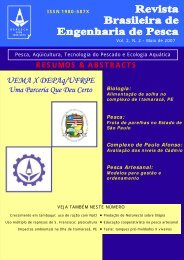Revista Brasileira de Engenharia de Pesca
Revista Brasileira de Engenharia de Pesca
Revista Brasileira de Engenharia de Pesca
Create successful ePaper yourself
Turn your PDF publications into a flip-book with our unique Google optimized e-Paper software.
ABSTRACT<br />
115<br />
Rev. Bras. Enga. <strong>Pesca</strong> 2[1]<br />
USE OF MACROPHYTE Egeria <strong>de</strong>nse PLANCHON, 1849 (HYDROCHARITACEA) IN THE<br />
PRODUCTION OF BRICKS AS ALTERNATIVE FOR CIVIL BUILDING<br />
In the reservoirs of river San Francisco, a new fact is happening since 1998 with the use of the waters<br />
of those reservoirs, also generating a new source of income for the area, through tilapias cultivations in<br />
tank-net. This new economical activity practiced in the reservoirs of the Hydro Electric Company of<br />
San Francisco, it is of fundamental importance for the regional <strong>de</strong>velopment, however needs to be the<br />
necessary careful so that it doesn't come to contribute with larger intensity in the process of<br />
eutrofization of the waters and consequent proliferation of aquatic macrophytes, being administered<br />
rations with pollutant potential bass and with high in<strong>de</strong>xes of alimentary conversion. This work search<br />
to optimize the use of biomass of aquatic macrophytes in the production of bricks ecological type it<br />
marinates (bricks of raw mud, dry in the sun), like this looking for a solution to the bloom of the<br />
macrophytes Egeria <strong>de</strong>nsa in the reservoirs of the hydroelectric plants that it is causing problems for<br />
CHESF, through the eutrofization of the reservoirs. The work was accomplished handma<strong>de</strong> in Paulo<br />
Afonso's fish culture, belonging CHESF. The experiment consisted of the use of E. <strong>de</strong>nsa for making<br />
of craft bricks. The biomass percentages ad<strong>de</strong>d to the clay for elaboration of the bricks were: 1%, 2%<br />
and 5% seeking to prove the percentile necessary of these macrophytes as agglutinant in the making of<br />
the bricks. And its has as goal also of suggesting the use of this material for constructions of low cost<br />
houses, since the adobe brick is used since the most remote times with this purpose. With the increment<br />
of the fiber of the macrophytes in right amount (5%) and being contrasted with the structure of a<br />
normal brick of adobe without macrophytes is verified in this last, more fissures than an adobe brick<br />
inoculated by this vegetable biomass and that in the resistance tests presented better results.<br />
KEYWORDS: adobe brick, aquatic macrophytes, handling of lakes<br />
INTRODUÇÃO<br />
Com os represamentos dos trechos encachoeirados do submédio São Francisco, visando a<br />
produção energia hidrelétrica, possibilitou a formação <strong>de</strong> gran<strong>de</strong>s lagos artificiais, com amplas<br />
possibilida<strong>de</strong>s <strong>de</strong> também serem explorados economicamente por meio <strong>de</strong> uma piscicultura racional em<br />
gaiolas flutuantes (TENÓRIO et al., 1999).<br />
Com a formação dos reservatórios, a colonização das áreas adjacentes vem crescendo a um<br />
ritmo acelerado, provocando muitas vezes a <strong>de</strong>rrubada da vegetação ciliar das margens do rio São<br />
Francisco, que pouco ou nada sobrou. A vegetação existente hoje em suas bordas e ilhas é


